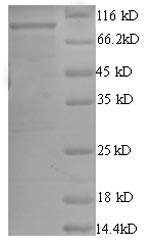The production of this Recombinant E.coli K12 MPL protein began at the genetic level, where the coding sequence for the MPL protein was first isolated and cloned into an expression plasmid vector. Recombinant DNA technology was used in the process. Next step was cloning. The expression vector must be introduced into the host cell (E.coli) so that the cells could be cultured and expressed the desired rep protein. And we finally got the recombinant rep protein with the purity of 90%+ determined by SDS-PAGE.
Extracellular adenosine triphosphate (ATPe) is an important signaling molecule, which regulates a wide range of cellular functions including cell proliferation, apoptosis, immune response, neurotransmission and, focus of our interest, the epithelial ion transport. In order to achieve these effects, ATP is released from cells in response to a number of stimuli including transmitter or hormone stimulation, shear stress, cell volume changes, hypoxia and release from damaged cells. Several ATP release mechanisms have been proposed to explain transport of ATP across the plasma membrane. One of the ATP releasing pathways is the regulated vesicular exocytosis, which occurs in neurons, endocrine cells and some exocrine cells, and constitutive vesicular transport. Other models of ATP release pathways include anion channels and transporters (e.g. maxi-anion channels, volumeregulated anion channels, cystic fibrosis transmembrane conductance regulator (CFTR)), multidrug resistance proteins, pannexin-1 and pannexin-1 in conjunction with the P2X7 receptor and connexin hemichannels.






